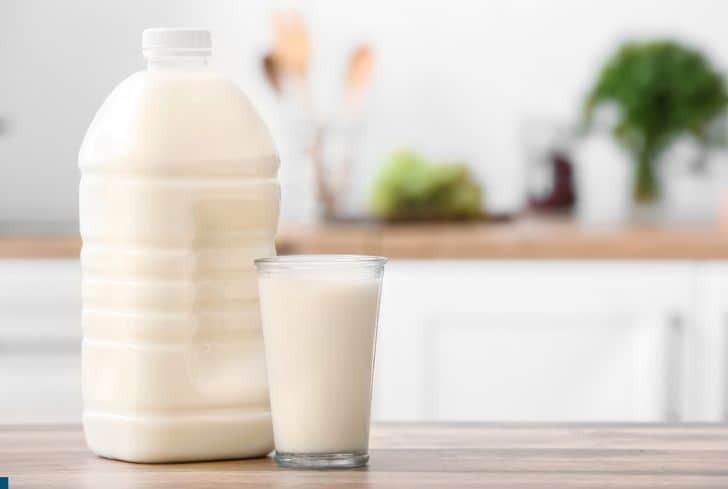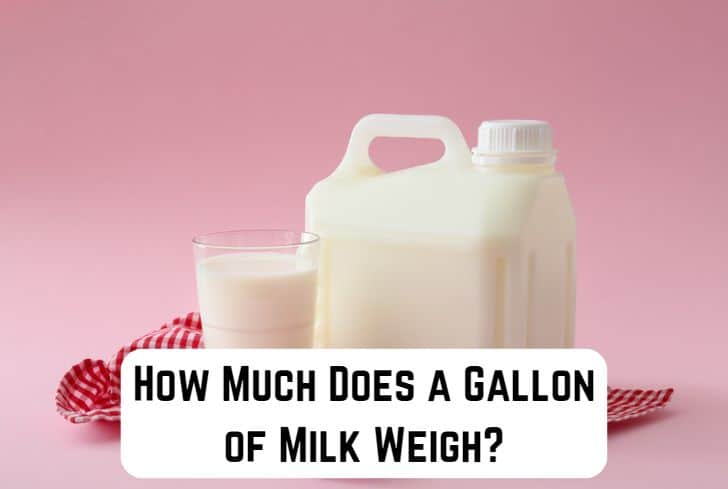Have you ever wondered how much a gallon of milk weighs? You’re not alone. Many people might curiously ask this question while lugging a heavy gallon from the grocery store to their refrigerator. Knowing the weight of a gallon of milk can help you better understand the heft you’re experiencing and may even make it a fun fact to share with others.
Weight can vary depending on the type of milk you’re dealing with, such as whole milk, skim milk, or something in between. For instance, a gallon of whole milk weighs approximately 8.6 pounds, while a gallon of skim milk weighs around 8.4 pounds. As you can see, even though the difference is minimal, the milk type plays a role in the overall weight.
Read: How Much Does a Cup of Sugar Weigh: Quick and Easy Guide
How Much Does a Gallon of Milk Weigh?
When it comes to milk, the weight can vary depending on the type and fat content. Here, we’ll take a look at the approximate weight of a gallon of whole milk, reduced-fat milk, and skim milk.
Whole Milk
A gallon of whole milk typically weighs about 8.6 pounds or 3.9 kg. This weight accounts for both the liquid and its nutritional components, such as water, fat, protein, carbohydrates, and minerals. Here’s a breakdown of the weight for different volumes of whole milk:
- 1 gallon: 8.6 pounds (3.9 kg)
- 1/2 gallon: 4.3 pounds (1.95 kg)
- 1 quart: 2.15 pounds (0.975 kg)
Reduced Fat Milk
Reduced fat milk, such as 1% and 2% milk, has a slightly different weight due to the reduced fat content. For example, a US gallon of 2% milk weighs approximately 8.4 pounds. The weight difference from whole milk isn’t much, but it’s still noticeable. Here’s the weight breakdown for different volumes of 2% milk:
- 1 gallon: 8.4 pounds (3.81 kg)
- 1/2 gallon: 4.2 pounds (1.90 kg)
- 1 quart: 2.10 pounds (0.95 kg)
Skim Milk
Finally, skim milk has the least fat content and weighs the least of the three types. Although an exact weight is harder to pin down, skim milk remains lighter than whole milk and reduced fat milk. Expect the following approximate weights for different volumes of skim milk:
- 1 gallon: Slightly less than 8.6 pounds (3.9 kg)
- 1/2 gallon: Slightly less than 4.3 pounds (1.95 kg)
- 1 quart: Slightly less than 2.15 pounds (0.975 kg)
In conclusion, remember that the weight of a gallon of milk can vary based on the milk’s type and fat content. Remember this information the next time you pick up a gallon of milk at the store.
A gallon of whole milk weighs approximately 8.6 pounds, while a gallon of skim milk weighs around 8.4 pounds. As you can see, even though the difference is minimal, the milk type plays a role in the overall weight
Measuringly.com
Factors Affecting Milk Weight
Temperature
Temperature plays a significant role in the weight of milk. When milk is colder, its density increases, which means it will weigh more. Conversely, as the milk warms up, it becomes less dense and will weigh less.
For instance, a gallon of whole milk at room temperature weighs approximately 8.6 pounds, while the same amount of milk stored in cold conditions might weigh slightly more due to increased density.
Packaging Material
The material used to package milk also affects its overall weight. Most commonly, milk packaging consists of plastic containers, glass bottles, or cartons. The weight of the packaging material itself adds to the total weight of the milk you buy. For example, a glass bottle will typically weigh more than a plastic container, leading to a heavier total weight when filled with milk.
To make it easier to understand, here’s a breakdown of different packaging materials and their approximate weights:
- Plastic containers: 0.1 – 0.3 pounds
- Glass bottles: 0.5 – 1 pound
- Cartons: 0.1 – 0.2 pounds
Keep in mind that these packaging materials can vary in weight, so the actual additional weight may be slightly different.
Throughout your day, you might not notice the difference in milk weight due to factors like temperature and packaging material. However, it’s interesting to know the various factors contributing to the overall weight of milk you consume.

Comparison With Other Liquids
In this section, we’ll compare the weight of a gallon of milk with other common liquids such as water, gasoline, and cooking oils.
Water
Water is often used as a baseline when it comes to the weight of liquids. A gallon of water weighs around 8.34 pounds or 3.79 kilograms. In comparison, a gallon of milk weighs approximately 8.6 pounds or 3.9 kilograms, making it slightly heavier than water. This difference is due to milk’s higher fat content.
Gasoline
Gasoline is another liquid you might be curious about. A gallon of gasoline weighs less than water and milk, weighing around 6.2 to 6.3 pounds or 2.79 to 2.83 kilograms. Gasoline is lighter because it’s composed mainly of hydrocarbons, which have a lower density than water or milk.
Cooking Oils
Cooking oils can vary in weight, depending on the type of oil. Here are some common cooking oils and their approximate weights per gallon:
- Olive oil: 7.6 pounds or 3.45 kilograms
- Vegetable oil: 7.7 pounds or 3.49 kilograms
- Coconut oil: 8.0 pounds or 3.63 kilograms
As you can see, cooking oils generally weigh less than both milk and water. This is because oils are made up of fatty acids, which have a lower density than water-based liquids.
In summary, a gallon of milk is slightly heavier than water, lighter than cooking oils, and significantly heavier than gasoline. These differences in weight are due to the varying density and composition of each liquid.
Read: How Much Does a Gallon of Sand Weigh? (We Know)
Practical Applications
Grocery Shopping
When you’re at the grocery store, knowing that a gallon of milk weighs approximately 8.6 pounds can help you plan your shopping trip more efficiently.
For example, if you need to purchase multiple gallons of milk, you can anticipate the added weight in your shopping cart and plan accordingly. This might involve using a larger cart or distributing the weight evenly to make it easier to navigate the store.
Baking and Cooking
Understanding the weight of a gallon of milk can also be helpful in baking and cooking. Recipes often require precise measurements of ingredients, and knowing the weight of milk can help ensure you’re using the correct amount.
Additionally, different types of milk can have slightly different weights, as the density of the milk varies depending on its fat content. For example, a gallon of whole milk weighs 8.6 pounds while a gallon of skim milk may weigh slightly less.
Here’s a quick reference for estimating milk weights in recipes:
- 1 cup of milk: approximately 0.54 pounds
- 1 pint of milk: approximately 1.08 pounds
- 1 quart of milk: approximately 2.15 pounds
- 1/2 gallon of milk: approximately 4.3 pounds
Transportation and Storage
Knowing the weight of a gallon of milk can be useful when transporting and storing your groceries. The added weight of milk can affect the way you load your car or carry your groceries home. By considering the weight of the milk in your shopping bags, you can avoid overloading and potentially prevent injuries or spills.
Additionally, storing milk in your refrigerator can sometimes require reorganizing your shelves. Knowing the weight of a gallon of milk can help determine if your refrigerator shelves can support the added weight, especially if you’re storing multiple gallons simultaneously.
In summary, understanding the weight of a gallon of milk has practical applications in grocery shopping, baking and cooking, and transportation and storage. By keeping this information in mind, you can make better-informed decisions and improve your overall experience when handling and using milk daily.







